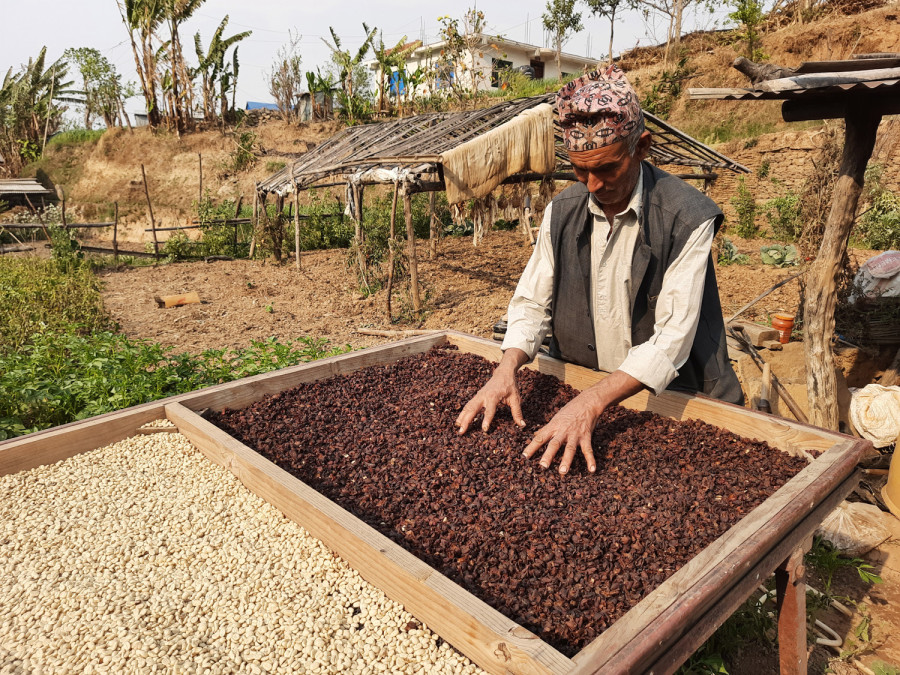Columns
Money from coffee cherry skins
After removing the coffee beans, the cherry skins are pulped and dried to make cascara tea.
Sanjib Chaudhary & Nagendra Bastakoti
Coffee, one of the most widely traded high-value agricultural commodities, involves up to 25 million farming families worldwide, mostly smallholders. Nepal too has been commercially producing Arabica coffee for the last three decades. As per the National Tea and Coffee Development Board’s 2019-20 data, 26,719 smallholder Nepali farmers produced 296.5 tonnes of coffee on 2,360 hectares. The district of Kavrepalanchok led the production with 34 tonnes, followed by Gulmi and Lalitpur districts with 24 tonnes and 18 tonnes production respectively.
According to the development board’s 2019-20 figures, Nepal exported 46,893 kg of coffee earning Rs57.7 million. The highest consignment of 13,002 kg went to Germany followed by Switzerland and Japan with 9,058 kg and 5,572 kg respectively. During the same period, Nepal imported 266,172 kg of coffee worth Rs118.8 million. The imports came mainly from India, Italy, and Malaysia amounting to 251,915 kg, 5,518 kg and 3,944 kg respectively.
Unused coffee cherry skins
Despite the increasing coffee production and exports to international markets, Nepali farmers have not been able to get the most from coffee cherry skins–sold and consumed as cascara tea in international markets. However, coffee cherry skins, either dumped or used as compost in Nepal, are set to be offered as cascara tea. In Sindhupalchok, coffee farmers have started preparing cascara products for home consumption. Thanks to an exchange visit to Peru, facilitated by Practical Action, farmers from Sindhupalchok saw, experienced, and learned the cascara preparation technology. The organisation engaged coffee producers, pulper operators, district coffee cooperative union, Nepal Coffee Producers Associations, and other stakeholders to further promote cascara tea.
“It is a sustainable solution for the environment, and reduces waste thrown into rivers or other water sources,” said Rudra Basnet, a lead coffee farmer from Melamchi, Sindhupalchok. “Besides, it provides additional sources of income for coffee producers by converting waste into cash and increasing job opportunities.”
Cascara or coffee cherry skins have been used for over 1,000 years in Ethiopia, the birthplace of coffee, and for hundreds of years in Kenya, Yemen and Bolivia, writes Joel Jelderks, co-founder and managing director at Caskai, a company producing cascara-based beverages.
Called cascara in Spanish, the coffee husks are sold and consumed as sultana in Bolivia, hashara in Ethiopia, and qishr in Yemen. After removing the coffee beans, the cherry skins are pulped and dried in the sun (not in the direct sun). They are then packaged and delivered to consumers around the globe. In these countries, the dried coffee cherries are usually steeped with spices like ginger, nutmeg, honey and cinnamon. In recent decades, coffee growers in Latin America have been brewing cascara tea along with coffee.
Cascara tea looks similar to loose leaf tea, but the cherry remnants are slightly larger. It tastes somewhere between coffee and tea. Although it comes from a coffee tree, it doesn’t have the same taste as the coffee bean it grows with. Being less expensive, cascara tea is widely served more than coffee in Yemen. It is also gaining popularity around the globe due to its lower caffeine content than coffee. The dark brewed cascara tea has 111.4 mg per litre caffeine while coffee contains 400-800 mg per litre caffeine. The quality of cascara drink strongly depends on variety, cleaning, drying, packaging, and delivery. Cascara tea can be prepared and drunk as per a person’s need and interest. It can be served hot or cold with different flavours and additives.
Besides the cascara drink, dried cascara can be ground into good quality powder. The powder can be used in various products like cookies, muffins, fruit and nut bars, desserts, bread, chocolates, ice creams, soft drinks, and sauces in various proportions. It can be mixed with other types of flour in a proportion of 10 to 25:100. However, it depends on the taste and preference of consumers. Since it contains so many antioxidants, its shelf life is longer than that of other products.
Cascara contains chlorogenic acid which can help to reduce blood pressure. Chlorogenic acid is a phenolic compound widely found in some fruits (apples, pears, blueberries, and strawberries) and vegetables (carrots, tomatoes, eggplants, potatoes, and sweet potatoes) and in coffee and tea. Chlorogenic acid reduces food craving, reduces the daily calorie intake, and induces body fat loss by thermogenesis. The pulp contains large amounts of antioxidants, fibre, vitamins, and minerals, and helps in anti-inflammatory activity in the body. It is believed that it may control blood sugar levels. In addition to this, it may help lose bodyweight and may also help to improve mood and cognitive function and prevents bacterial infections.
Economic importance
In 2019-20, coffee produced in Nepal and Sindhupalchok district amounted to 296.5 tonnes and 15 tonnes respectively. Based on that figure, about 75 tonnes of dry cascara (11 percent moisture) could have been produced in Nepal and 3.8 tonnes in Sindhupalchok alone. The economic value would be Rs56 million to Rs100 million (estimated from selling prices of cascara in Peru, Bolivia, and Tokyo and Indian and European shops where it is selling for Rs1,000–Rs1,800 per kg). Till date, the cherry skins are being discarded.
The economic, health and environmental benefits of coffee cascara are known to some extent. However, in Nepal, it is less known and less explored. Since the consumption of cascara is at an early stage in Nepal, there is a lot to do including research to improve its quality and identify the other quality parameters (namely variety, altitude, processing methods, and consumer preferences) in the Nepali context. If a market is assured for cascara and its products, farmers would be able to earn additional income and be motivated towards expanding the coffee acreage. Ultimately, this may encourage the utilisation of areas left fallow in the hilly region.




 14.12°C Kathmandu
14.12°C Kathmandu
















